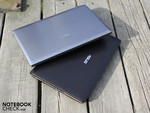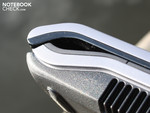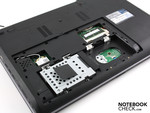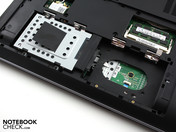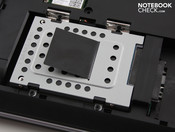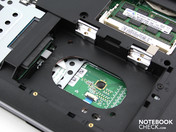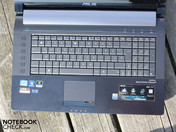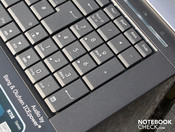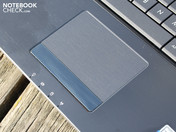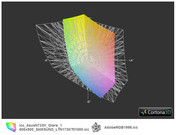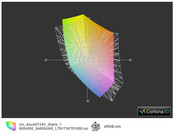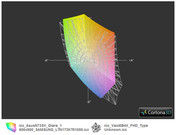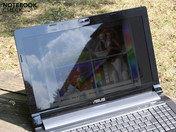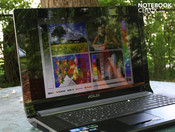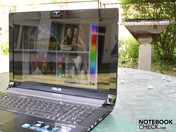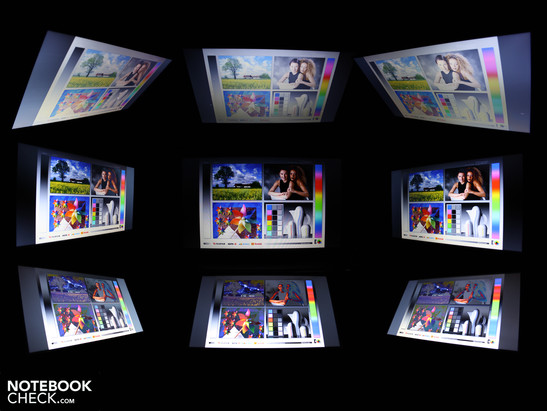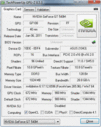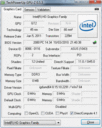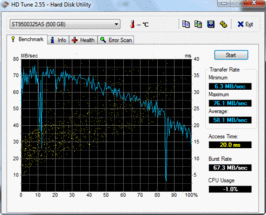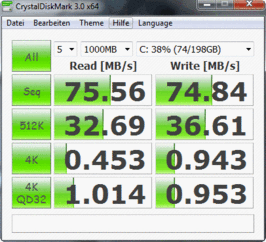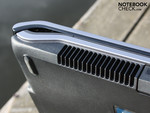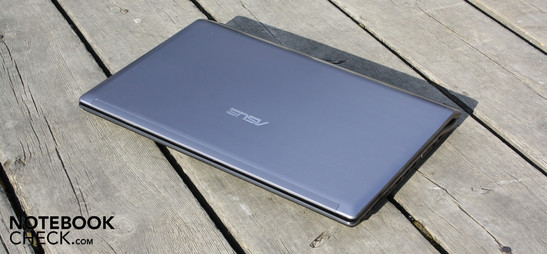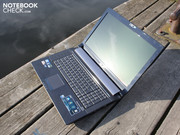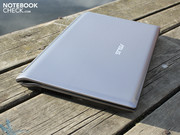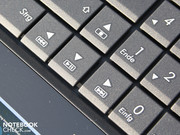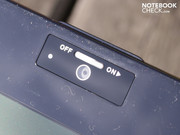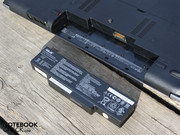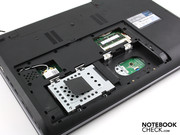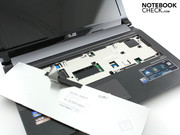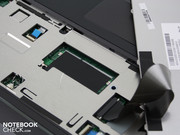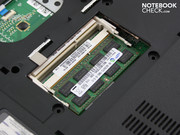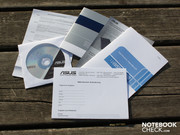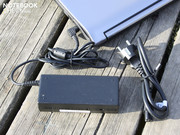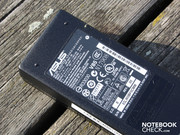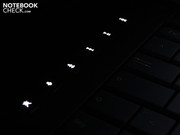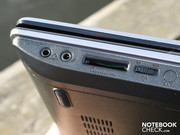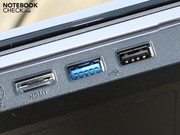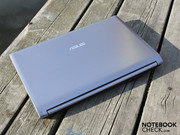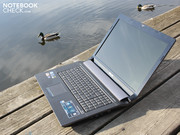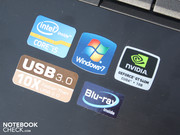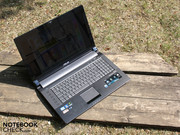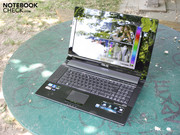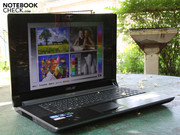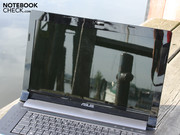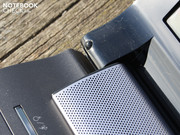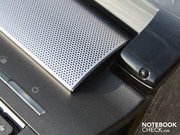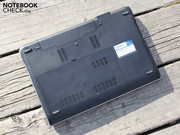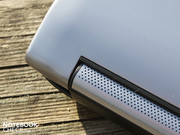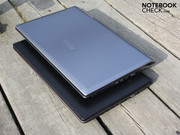Review Asus N73SV Notebook

In November 2010, a genuine multimedia desktop replacement went through our tests. The N73JQ-TZ087V with a fat quad core processor (Core i7-740QM) and GeForce GT 425M. Price: 1270 euros. The graphics performance was a bit too weak for gaming, but the so-called ICEpower & Sonic Master Audio System presented itself from its best side. Even the Full HD screen with great viewing angles was the perfect partner for high definition movie entertainment via BluRay (ROM).
The demand was likely low due to the high price. This can only be guessed because the predecessors are on the virtual shelves today. Even the most expensive version (N73SV-V1G-TY279V) with a Core i7 2630QM costs less than 1000 euros (2x500 GB, WXGA++). We opt for low cost and have brought the N73SV-V1G-TY282V with a Core i5-2410M (2x2.30 GHz) and NVIDIA GeForce GT 540M into our editorial office.
In which points have cutbacks been made in the previous showpiece model, N73JQ-TZ087V ? Has the workmanship also changed? What does the quality of the 17.3 inch WXGA++ screen look like? Is the N73SV still a milestone in laptop acoustics? All answers in this review.
Case
The N73SV's heavy and large case is impressive at first glance. Of course, not with elegant portability – the 3448 grams radiate robustness and high quality. Nothing has changed in comparison to the N73JQ in this regard – but a few details have. The screen no longer is hidden behind a Plexiglas plate (edge-to-edge display bezel). This isn't much of a loss though, especially since the screen reflects intensely either way.
Otherwise, all remains as usual. The majority of the surfaces are made of brushed aluminum (lid, wrist-rest, loudspeaker cover). The wrist-rest is massive and can't be depressed anywhere. The lid's torsional stiffness has suffered though. It can be twisted to an extent when it's picked up at the corners. Its aluminum surface can only be depressed marginally with a lot of force in the center.
The hinges are firm in place and are pulled tight. A firm stop indicates the maximum opening angle of about 135 degrees. It is sufficient for use on the lap.
The plastic base tray can't be dent, not even at the vents. We find the dual HDD option (1x500 GB installed, 1 x 2.5 inch SATA unoccupied), the main memory (2 modules) and the WLAN module underneath a larger maintenance cover. However, the cover can only be removed when the screws underneath the keyboard are loosened. There is no longer a third RAM slot underneath it as was the case in the N73JQ.
Connectivity
The 17.3 incher brings along a lot of interfaces. Nevertheless, certain needs haven't been considered. Unfortunately, there is only one USB 3.0 port. The other three are the usual USB 2.0 ports. eSATA, available in the N73JQ, has been removed without replacement. Retrofitting interfaces, e.g. iLINK, is not possible due to the lack of an ExpressCard slot.
The position of the rear connections (2 USBs, LAN) makes sense. Cables for HDMI or VGA only occupy one side of the desk. The analog out is combined with the optical S/PDIF.
Communication
WLAN in the latest draft n is just as much standard as an integrated Bluetooth module (3.0 +HS) gigabit Ethernet. If you have a T.V. set with an INTEL WIRELESS DISPLAY support, the Centrino Wireless N 1000 adapter and core processor provide a wireless video transmission to the television. The software "My WiFi" technology (Intel MWT) and wireless display has to be installed and enabled.
Supplies
There is no recovery data carrier for Windows 7 Home Premium (64bit). An according DVD has to be burnt with the AI Recovery Burner. LiteFrame, a tool for taking pictures or recording videos with the webcam, can shoot pictures in 1600x1200 pixels. The webcam however lacks brightness in this resolution and needs a long exposure time for reasonably focused pictures. The same applies to videos, which can only be recorded in a much lower resolution. The results in medium resolutions are very good in daylight. But picture noise and streaks develop in poor lighting conditions.
The equipment with the tools: PowerDVD10 (creator), PowerDirector V8 (editor), MediaShow Espresso (converter) and Asus Video Magic (creator and burn) belong to the pre-installed (full version) software. The user can thus start with video editing without additional costs right away.
Warranty
Asus bids a 24 month warranty with pick up & return service. A warranty extension to three years is available for about 80 euros. It has to be activated within 90 days.
Input Devices
Keyboard
As to the keyboard unit, Asus regrettably hasn't made any improvements. It remains to be a mistake like in the N73JQ. The stroke is as spongy and soft as before, which is due to the yielding key surface. Consequently, the clear key drop isn't effective. The arrow keys are very crowded despite the vast available room.
Hot Keys
The multimedia control left of the keyboard allows fast input during movies. Beside the usual play/stop/fast forward/rewind, the volume is also controlled or muted here. The clicking keys light up weakly depending on the state. A button above the hot keys switches among the Asus energy modes (silent office, etc.).
Touchpad
The mouse replacement is made of hard, slightly textured plastic. The surface is touch-sensitive up to its edges. The pad doesn't have any vertical or horizontal scroll bar. Scrolling is however possible via multi-finger gestures. Thus, implemented scroll bars are no longer mandatory.
The keys click loudly, but first after a difficult to overcome pressure point. Unfortunately, the noise is so loud that it soon gets annoying.
Display
The 17.3 inch screen can only meet the high expectations with a viable brightness. The screen has a resolution of 1600x900 pixels (WXGA++; 16:9). If you need a very clearly arranged desktop, you can work well with this resolution. The display has a weakness with a low contrast of 163:1.
The glare type pretties up the weak contrasts optically, though. Consequently, a visually acceptable color impression is created. The screen isn't suitable for professional picture editors since the color spectrum doesn't even cover sRGB (t).
| |||||||||||||||||||||||||
Brightness Distribution: 93 %
Center on Battery: 232 cd/m²
Contrast: 163:1 (Black: 1.42 cd/m²)
56.2% AdobeRGB 1998 (Argyll 3D)
76.1% sRGB (Argyll 3D)
55.4% Display P3 (Argyll 3D)
The brightness assessment on the 17.3 inch screen shows adequate results. The average brightness is 228 cd/m2. Gossen's Mavo Monitor measures up to 232 cd/m2. As a result, the illumination is very even with 94 percent. Users hardly ever need a brightness beyond 150 cd/m2 indoors.
If you place the Asus N73SV in the sun, you should look for a shady place to avoid reflections. Our pictures were taken in cloudy conditions and in maximum brightness. The result is quite viable since the screen isn't dimmed in battery mode. However, reflections will be annoying depending on light incidence.
We can move up to 60 degrees from the frontal view horizontally. The colors start to invert beyond that. However, the brightness remains constant past that and script can be read up to 70 degrees. The negative effect starts at 15 degrees vertically. We experience the greatest restrictions when looking down or up from the sides. Thus, placing several people in front of the display isn't a good idea. We have depicted the viewing angles in a video.
Performance
The Intel Core i5-2410M (2x2.3 GHz) has a Turbo rate of up to 2.9 GHz. The 2011 Intel Cores can increase the clock rate beyond the defined maximum rate with "Dynamic Range @ Turbo Frequency Limits", providing that the cooling allows it and certain temperature limits are maintained.
The Nvidia Geforce GT 540M (1024 MB) is not solely responsible for 3D calculations. The graphics chip, HD Graphics 3000, in the i5 processor is enabled and takes over graphic calculations when Nvidia Optimus disables the dedicated GPU. The RAM configuration is 4GB, whereas one 4096 MB module is inserted.
What is the 2410M (2x2.3 GHz) capable of in comparison to the 2010 i5 generation? The 2410M achieves good 4607 points in single core processing (Cinebench R10 Single 64bit). A higher clocked 2010 460M (2x2.53 GHz, Turbo 2.8 GHz) is defeated with 3939 points (e.g. Acer Aspire 3820TG, 13.3 inch).
If you decode movies with Video Magic, you'll benefit from multi-threading with a higher clock rate. The 2410M reaches 9791 points in the according test. The 2010 i5-460M (4 threads) is clearly defeated: 8060 to 8342 points (e.g. Acer Aspire 5820TG). In contrast, the newest sister model, i5-2520M (4 threads), can only run up a marginal advantage to 10128 points (Cinebench R10 Multi 64bit).
| PCMark Vantage Result | 5775 points | |
Help | ||
PCMark Vantage determines 5775 points. That is about as much as i5-460M systems from 2010 achieve (up to 6000 points, e.g. Acer Aspire). This system performance score is only dependent to an extent on the graphics card. Thus, the fairly strong GeForce GT 540M hardly has an impact with its 7902 3DMarks06. It's sooner the rotating HDD that keeps the system on the ground. PCMark Vantage scores of 10000 up to 14000 points would be easily possible with an SSD (flash memory for the hard disk). For example, the Schenker XMG A701 with 14285 points.
| 3DMark 03 Standard | 20802 points | |
| 3DMark 05 Standard | 15690 points | |
| 3DMark 06 Standard Score | 7902 points | |
| 3DMark Vantage P Result | 4179 points | |
| 3DMark 11 Performance | 979 points | |
Help | ||
As said, performance boosts can't be expected from the hard disk due to its rotating characteristic. PCMark Vantage's HDD sub score is only 3350 points. Fast 7200 rpm hard disks first achieve up to 4000 points. SSDs play in a completely different league (20000 to 36000(!) points). For example, see the XMG A701 with an Intel 510 Series X-25M Elm Crest: 36720 points (HDD sub score). The hard disk (500 GB) from Seagate only reads with 58 MB/s in sequential read (HD Tune). Our comparison Elm Crest SSD reaches 302 MB/s in read.
The GeForce GT 540M (1024 MB DDR3) belongs to the upper GPU midrange. The chip based on the GF108 core (Fermi) supports both DirectX 11 and GDDR5 memories. However, the slower and cheaper DDR3 video memory is installed, as usual. It clocks with 900/900 MHz (core/memory), which is at the upper end of the specifications. For example, Acer uses 800 MHz (Aspire 5742G). The GPU supports Optimus and can be disabled in favor of the Intel HD 3000.
Synthetic Benchmarks
3DMark2006 (1280x1024) finishes with strong 7902 points. A Radeon HD 6850M (~9700 points) can beat this with the same memory unit. The HD 6550 and 6650 (~7515), the Radeon competitors, are slightly defeated. The 3DMark Vantage score (4179p) can also surpass the HD 6550M (3700p). 3DMark11 achieves 979 performance points. The HD 6550M (1107p) and even the older HD 5650 (1024p) look better here.
Risen (2009)
The 900 MHz clock rate supports the GT 540M. Not very long ago, a maximum of 24 fps was stated in the database with the i5-450M in high details. Now it is at least 27 fps. The graphically intricate adventure is smoothly playable in a mix of high and medium details.
| Risen | |||
| Resolution | Settings | Value | |
| 1366x768 | all on/high, 4xAF | 26.8 fps | |
| 1024x768 | all on/med, 2xAF | 38.7 fps | |
StarCraft 2
The real time strategy game can serve with a smooth game play in high details, even if not in the native 1600x900 pixels. The frame rate drops to about 22 fps. 33 fps in high are roughly 20% more than the Radeon HD 6650M and 6550M could offer (however, with an older i5-480M or the like).
| StarCraft 2 | |||
| Resolution | Settings | Value | |
| 1360x768 | high | 32.7 fps | |
| 1360x768 | medium | 46 fps | |
Gaming Verdict
Our fast trip into the world of games again shows the Geforce GT 540M (@900MHz memory) as a strong companion in the world of games. When you don't switch to the native 1600x900 pixels and antialiasing is kept at a low level, most of the latest games can be played in medium and high details (1366x768). The N73SV is nevertheless not a strong gamer. You would at least need a GeForce GT 445M/GT 555M or a Radeon HD 5850/HD 6850 if you always want to play the newest tracks. For more gaming tests with the GT 540M at hand, we would refer to its data sheet.
| low | med. | high | ultra | |
|---|---|---|---|---|
| Risen (2009) | 38.7 | 26.8 | ||
| StarCraft 2 (2010) | 46 | 32.7 |
Emissions
System Noise
Who wants to be disturbed by a loud fan? Asus solves the waste heat problem exemplarily. The system noise doesn't go beyond 35.2 dB(A) during normal load, such as a computer game. If you only surf on the Web or type in Word, you won't hear the fan at all with 31.7 dB(A). The fan is never inactive in idle, but its noise is extremely quiet.
Not even the stress test can push the noise over 35.6 dB(A). The fan blow constantly, but is never annoying. The read and write heads of the hard disks are not audible in use because the level is below the fan's normal level of 32 dB(A) (idle, low load).
Noise level
| Idle |
| 31.2 / 31.4 / 31.4 dB(A) |
| HDD |
| 31.7 dB(A) |
| DVD |
| 39.6 / dB(A) |
| Load |
| 35.2 / 35.6 dB(A) |
 | ||
30 dB silent 40 dB(A) audible 50 dB(A) loud |
||
min: | ||
Temperature
The bulky case has a lot of room for distributing the waste heat. The bottom's average temperature is 25 degrees Celsius while surfing and word processing. The wrist-rest's area is cool with 24 degrees.
The waste heat in the stress test only changes the temperature graph insignificantly. The infrared thermometer only measures 31 degrees selectively on the top during maximum CPU/GPU load. The wrist-rest however doesn't get warmer than 24 degrees here, either. The temperature is also only noticed in the fan's vicinity on the bottom: 38 degrees.
(+) The maximum temperature on the upper side is 31.2 °C / 88 F, compared to the average of 36.9 °C / 98 F, ranging from 21.1 to 71 °C for the class Multimedia.
(+) The bottom heats up to a maximum of 37.5 °C / 100 F, compared to the average of 39.2 °C / 103 F
(+) In idle usage, the average temperature for the upper side is 25.4 °C / 78 F, compared to the device average of 31.3 °C / 88 F.
(+) The palmrests and touchpad are cooler than skin temperature with a maximum of 25.7 °C / 78.3 F and are therefore cool to the touch.
(+) The average temperature of the palmrest area of similar devices was 28.7 °C / 83.7 F (+3 °C / 5.4 F).
Speakers
Asus has developed its own audio standard, "Sonic Master", in collaboration with Bang & Olufsen. All devices of the N range are to receive a very good laptop sound with this. According to Asus, the N73SV has an 11 watt amplifier (three watts are standard). Our N73SV manages without a subwoofer. Two stereo speakers with large membranes are located underneath the silver bar above the keyboard.
Midranges and trebles are played excellently because they are balanced. Music and speech are perceived as clear as crystal, no matter if we stand in front of, beside or in the back of the laptop. The only flaw: basses are rendered, but not as powerful as the one or other notebook with a subwoofer has proved possible (e.g. Asus N71JV, Asus G73JH). The N73JQ's sound quality has been maintained. Please see the previous Sonic Master review for a video demonstration.
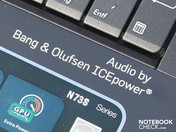
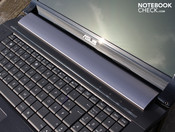
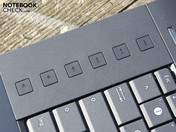
Battery Life
17 inches are normally not the avant-garde of strong battery runtimes. The N73SV tries to correct this image a bit. The 56 watt hour battery does its best for this (5200 mAh). In addition, there is a low idle power consumption of 17 to 24 watts for the 17 inch category.
It achieves just less than five hours (281 minutes) in idle. The 17.3 incher lasts for a whole four hours (244 minutes) when surfing via WLAN. You can easily play an overlength movie with 207 minutes (3:27 hours) when you watch a DVD movie on the go. The predecessor, Asus N73JQ, couldn't even come close to reaching these runtimes. The reason: a quad core CPU, 47 Wh and an idle power consumption of 19 to 29 watts The WLAN runtime was 2 hours.
The low (for a quad core) power consumption of 17.4 watts in idle (idle, minimum) confirms the viable office runtimes. However, the multimeter quickly climbs to 24.5 watts in high performance mode (wireless on, maximum brightness, idle). That is still less than the Asus N73JQ-TZ087V (740QM, 19.3 to 29.5 watts) drained from the power outlet.
The counterpart is the power consumption during load. The N73SV is greedy with 93 watts in the CPU and GPU stress test (Prime95, Furmark). It only demands 67 watts (@3DMark2006: 64 watts) when only the GT 540M is calculating (Furmark). Thus, the 90 watt adapter could be overburdened in the extreme case. However, the adapter's temperature stays within limits with 49 degrees in practical use. The elbowroom during power output appears to be sufficient. Also, games don't drive the N73SV beyond 70 watts, as aforementioned.
| Off / Standby | |
| Idle | |
| Load |
|
Key:
min: | |
Verdict
Asus has a multimedia machine in its array that, like its predecessor N73JQ, provides a top-rate workmanship with the N73SV V1G-TY282V. That however doesn't apply to the keyboard, which still coils extremely and represents a major drawback of the otherwise high-end 17 incher.
The laptop scores with its acoustics (Bang & Olufsen), the ergonomics and feasible battery life from four to four and a half hours. The outdoor scenario is clearly dimmed by an intensely reflective screen, as usual.
The contrast weak WXGA++ screen (1600x900) doesn't fit in the image of a high-end multimedia 17 incher. The contrast rich Full HD screen (1920x1080) used in the predecessor, N73JQ, was more suitable for movies, pictures and games with its stable horizontal viewing angles.




